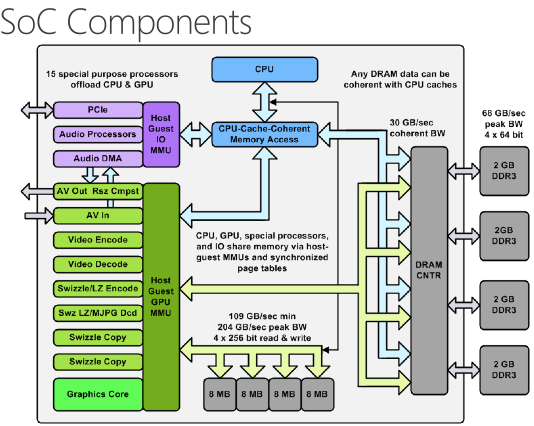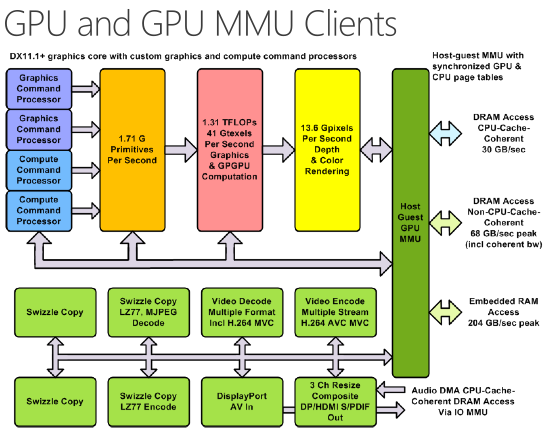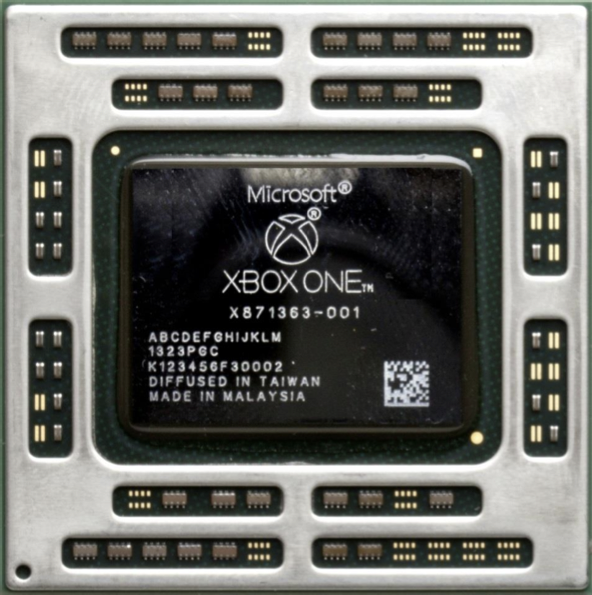Xbox One Review: Unifying Your Living Room Experience
We've been messing with Microsoft's Xbox One for a while now, and it's surprisingly hard to compare against Sony's PS4. Join us as we walk through the hardware, the software, and the console's role quarterbacking your more connected living room.
The Xbox One GPU: GCN-Based
While Microsoft and Sony both leverage AMD's Graphics Core Next architecture for their next-generation consoles, Microsoft's shader count is matched pretty well to the same Bonaire GPU found on the desktop Radeon HD 7790. Sony, on the other hand, appears to have a derivative of AMD's Pitcairn design found on the Radeon HD 7800s. Much has already been said comparing both devices and their capabilities. However, the fact that developers are running certain games at lower native resolutions on the Xbox One than the PS4 and then upscaling the output makes it pretty clear that Sony's GPU is more powerful.
But gaming consoles do not mirror the PC graphics card market. The fastest console doesn't always win, as Sega can attest to.
There are also some very significant differences between actual desktop GPUs and the hardware inside the Xbox One. For instance, Bonaire has 14 Compute Units. As we know, each CU has four Vector Units, and each VU contains 16 shaders. That adds up to 896 of AMD's Stream processors running at 1 GHz, in the case of Radeon HD 7790. We also know from digging deeper into the PS4 that Sony wanted eight of AMD's asynchronous compute engines in its GPU. AMD's mainstream GPUs have two. Clearly, they call these semi-custom designs for a reason.
The Xbox One's GPU sports 12 CUs, totaling 768 Stream processors, and a clock rate recently revised up to 853 MHz. Microsoft has also stated publicly that some of the GPU's resources will be reserved for the Kinect and operating environment, before we even get to differences in each console's memory bandwidth.
Microsoft equips the Xbox One's SoC with 8 GB of conventional DDR3-2133 memory in a quartet of channels. A 256-bit aggregate interface yields 68.3 GB/s of throughput, which is quite a ways behind the PS4’s 176 GB/s. But Microsoft has a trick up its sleeve. Taking a page from the Xbox 360 playbook, Microsoft embeds 32 MB in four 8 MB slices on 256-bit buses. At minimum, it's rated for 109 GB/s, though Microsoft also specifies a 204 GB/s peak.
Despite its comparatively less powerful GPU, AMD managed to build a very technically impressive SoC for the Xbox One. It measures a substantial 362mm2, which is pretty close to the Tahiti GPU on AMD's Radeon R9 280X measuring 352 mm2...and that's just a graphics processor. Yet, both are designed for next-gen gaming.
Get Tom's Hardware's best news and in-depth reviews, straight to your inbox.
Current page: The Xbox One GPU: GCN-Based
Prev Page The Xbox One CPU: Complements Of AMD's Jaguar µArch Next Page The Xbox One's Controller: Vastly Improved-
lostgamer_03 Great review, really made reflect over what a gaming machine should be able to do nowadays. A gaming machine isn't just a gaming machine anymore and the Xbox One, even though it might not be as powerful as PS4, is a really attractive product in my perspective.Reply -
Nahkman Reinventing the TV experience only applies to the Americas as the rest of the world does not really care much about ESPN, and also a lot of the functionality is NA only, there was also a rumor that kinect voice commands do not work in a lot of european countries.Reply -
Maziar Great reviewReply
At the time being,IMO PS4 is a better gaming machine;whereas,X1 is a better entertainment system.
PS4 has a more powerful GPU so it should perform better in games and is $100 cheaper too;whereas,X1 tries to do more than just gaming and costs more.
For me,PS4 is a better machine because I only tend to play games on a console but X1 is also a great machine -
de5_Roy 10 pages and.. nothing about xbone(R)'s gaming capability or gaming experience. the review was done well, but seems restricted to media capabilities. the device seems versatile.Reply
some of the ps4 reviews i read had info on gaming as well as media/entertainment. i mean info like how the games look and feel to a player, resolution and user perception, joystick (and other input devices) performance in gaming etc. -
daglesj As a 42 year old that back in 2006 played a lot of games on my console but now mainly uses it for media and streaming with a bit of gaming on the side (I'm sure I'm not the only one) the Xbox One is a more compelling unit than the PS4.Reply
I'm pretty sure MS went over the usage stats of the 360 and found that more and more people were using the media/TV/movie aspects. After all thats where the money is.
MS could sell half as many Xbox Ones as Sony but it will still be making far more per console in subscriptions and services. The money going forward isn't in games.
However, I don't think this generation will be as long lived as the 360/PS4. I see One.5 or PS4.5 models or total replacement within 5 years. -
zzzaac Unfortunately all these nifty things are half working or not working at all for countries other than US of AReply
I might be getting both, but to be honest I might not get any, as I've become more of a PC gamer -
cats_Paw I think im getting old, becouse when i read this i think that the Xbox one is basicly a low end PC with limited usability...Reply



